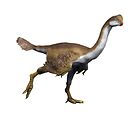Flexomornis
| Flexomornis Temporal range: Late Cretaceous,
| |
|---|---|
| Scientific classification | |
| Kingdom: | Animalia |
| Phylum: | Chordata |
| Clade: | Dinosauria |
| Clade: | Saurischia |
| Clade: | Theropoda |
| Clade: | Avialae |
| Clade: | †Enantiornithes |
| Genus: | †Flexomornis Tykoski & Fiorillo, 2010 |
| Species: | †F. howei
|
| Binomial name | |
| †Flexomornis howei Tykoski & Fiorillo, 2010
| |
Flexomornis (meaning "flexed shoulder bird") is a genus of enantiornithean birds known from fossils found in Texas rocks belonging to the Woodbine Formation (Lewisville Member) dating to the middle Cenomanian age of the late Cretaceous period. It contains a single species, Flexomornis howei, named for the amateur fossil hunter Kris Howe, who discovered the site where the fossils were found.[1][2]
References[]
- ^ Tykoski, R.S.; Fiorillo, A.R. (January 2010). ""An enantiornithine bird from the lower middle Cenomanian of Texas". Journal of Vertebrate Paleontology. 30 (1): 288–292. doi:10.1080/02724630903416068. S2CID 84037461.
- ^ "Flexomornis howei: A tale of amateur and professional cooperation". Deposits Mag. 2016-12-06. Retrieved 2022-01-30.
Categories:
- Euenantiornitheans
- Fossil taxa described in 2010
- Bird stubs















